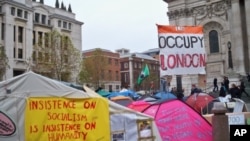The Occupy London protest site reached its 60th day Monday, running longer than its counterpart in New York did before it was dismantled. It now occupies three sites across the City of London - a cathedral courtyard, a square and a building. One of the sites even has an art gallery.
But with growth has come rivalry between the two, with criticism that some American protesters who have decamped to London from New York are too reliant on their creature comforts.
In London winter has set in. Tourists are wearing winter coats. It’s midday, and the dozens of brightly colored tents belonging to Occupy London protesters are firmly zipped up.
Between the first row of tents and the cathedral steps is this protester, Malcolm. He’s a member of a protest group called Anonymous UK and has been here since the start. "We think we have reached and breached our criteria and remit for being here. We’ve have members of Anonymous UK in the first aid tent, in the food tent, doing the cleaning, in the welfare tent, doing security in nighttime - we’ve lent dongles laptops, whatever is needed to make sure that Occupy London stays at top of its game," he said.
As the protest became more heavily supported in October and November, other sites across the financial district needed to be found. One is a square directly across from the UK office of Bloomberg, the financial information company. Another site is an empty building that used to belong to the Swiss Bank UBS. "A lot of the original faces from Occupy London and the visitors from other Occupies tend to get shepherded over there … We’ve no water over here, they’ve got electricity, carpets, they’ve got lights, they got ceilings, they got warmth, we don’t have any of that but then we are British and we are on the front line of our own Occupy," he said.
When asked if the American protesters were taking an easier path, Malcom said, "Yes I do. And I think some of the British are taking a soft option as well - I think it’s lazy and I think it is detrimental to the movement, if you are going to occupy the London Stock Exchange albeit on the steps of St. Pauls don’t go skulking off to a bank."
That rivalry is probably friendly more than anything. The protesters all share the same goal: a weakening of the grip financial services industry has on society.
And with that common purpose comes cooperation.
In a large white marquee outside St. Paul’s cathedral, 20 or so protesters are conducting the camp’s daily meeting.
Some protesters have been a bit aggressive at the tea tent during the night, and they’re trying to find a consensus on how to sort the problem out. They support another person’s comments not by applauding, but by silently wiggling their fingers and thumbs in the air.
The protest community hasn’t just found ways to cooperate, they’ve also found new ways to express themselves.
A mile away, in a square opposite the office of Bloomberg, Shaun Boyle stands chatting outside his tent. He used to work in financial services in the City of London. But he’s now undergone a dramatic change in his sympathies. "What happened, for me, was financial criminality, financial terrorism," he said.
But the tent he looks after isn’t designed to sleep in. It’s an art gallery! Last week, it showed a work by Banksy, one of the world’s most famous street artists who made a piece especially for Occupy London.
Shaun says the London protests are now more important than ever. "We’ve got such an opportunity here in the UK, because we are a financial center. And because New York is under the cosh, I feel we’ve really got to make a huge effort. ... And because we’re opposite Bloomberg and he is the mayor of New York I want to say support Occupy Wall Street and do not support Bloomberg," he said.
Next week the City of London authorities are going to court to try to get the tents removed permanently.
